Ancient Indo-European tradition supported by archaeological evidence
Source - http://www.archaiologia.gr/en/blog/2013/09/19/wolf-rites-of-winter/
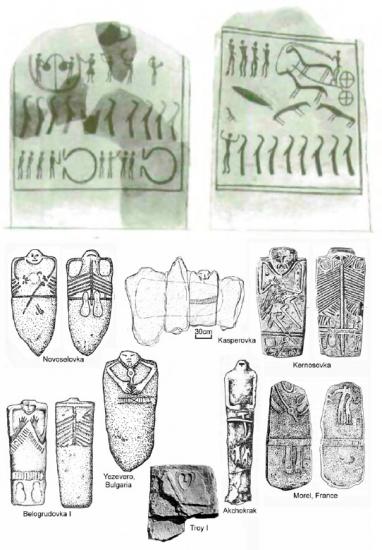
Objects providing pictorial evidence of initiation rites in different Indo-European cultures. Credit: D. Anthony.
“I remember saying early on in the dig that we were finding a lot of dog bones. But I had no idea how important they would turn out to be. When the team got to work analyzing all the animal bones in the lab, they identified the remains of about 51 dogs and seven wolves, as well as six canines that could not be classified as either. At other Timber Grave sites, dog and wolf bones never make up more than 3 percent of the total animal bones found. At Krasnosamarskoe, they made up more than 30 percent. “I don’t know of any other site in the world with such a high percentage of dog bones”.
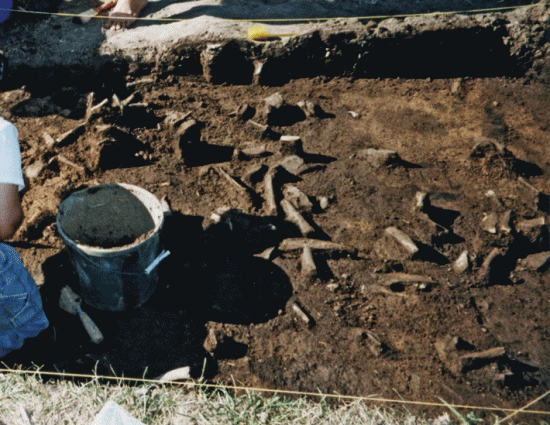
Archaeologists found chopped dog and wolf bones scattered at the small Bronze Age settlement of Krasnosamarskoe. (Courtesy David Anthony)
This is the way archaeozoologist Nerissa Russel describes the procedure of excavating Krasnosamarskoe, one of the most enigmatic sites in the history of modern archaeology. Situated in the Russian steppes north of the Black Sea, Krasnosamarskoe is an otherwise typical site representing the so called Timber Grave Culture, a nomadic culture that flourished in Northern Europe during the local Bronze Age. Still, the finding of an enormous amount of dog and wolf bones -also cut in unusual, systematic ways that did not resemble ordinary butchering practices- was a phenomenon its excavators, archaeologists David Anthony (Hartwick College) and his wife Dorcas Brown could not fully explain. The almost ceremonial cutting of these bones was reminiscent of a sacrifice. But why, and in what way?
The Indo-European connection
Enter the science of linguistics and especially the Indo-European language theory. It is generally considered that the people who lived at Krasnosamarskoe almost certainly spoke an Indo-European language, an event that implies cultural connections with a wide range of people inhabiting the area covering Northern and Central Europe, the Russian Steppes and India. Moreover, Proto-Indo-European (PIE), the language all Indo-European languages stem of (probably spoken between 4500 and 2500 BC), included words signifying certain cultural practices,which are well recorded in later Eurasian cultures. Such a word is “koryos”, signifying a group of young people acting like (and often getting inspiration by) wolf packs.
Dancing with the Wolves
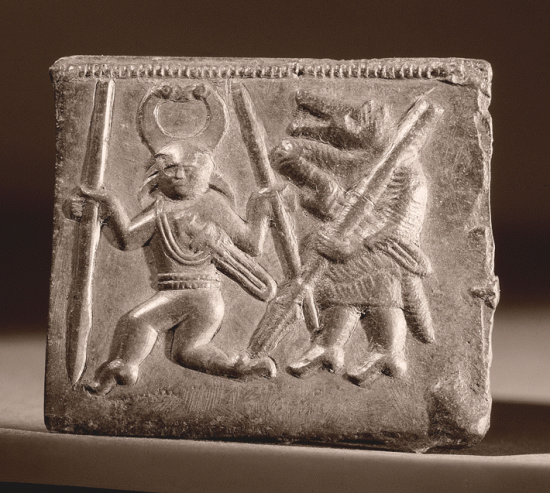
A bronze Viking plate from the 6th century A.D. depicts a helmeted figure who may be the god Odin dancing with a warrior wearing a wolf mask. (National Historical Museum Stockholm)
The institution of youthful war bands that go on seasonal raids is so widespread in Indo-European cultures that historical linguists and mythologists concluded that it had to be a long-standing PIE tradition. In the ancient Celtic, Germanic, Greek, and Indo-Iranian traditions, young men often left their families to form warrior societies. “These were young guys on the edge of society who occasionally would steal cows, and you’d rather they were off stealing someone else’s cows,” says Anthony. “So they were expelled from their social groups and told to raid other communities.” In Germanic traditions, these bands of young warriors thought of themselves as wolf packs. A famous myth about the hero Siegfried has him donning a dog skin to go raiding with his nephew, whom he is training to become a warrior. In the Rigveda, an ancient Sanskrit text composed sometime before 1000 B.C., young men can only become warriors after sacrificing a dog at a winter ceremony and wearing its skin for four years, which they burn upon their return to society. Such mid-winter actions are also stated through other traditions, allowing scholars to support that in a distant past, young men became warriors during a mid-winter ritual that involved dog sacrifice (probably because of the physical resemblance of dogs and wolves).The archaeological context has provided iconographical evidence which supports the above traditions. A stele found in a tomb near Kivik, Sweden, dating from about 1300 to 1000 B.C., depicts eight hooded figures follow a leader. The depiction has been interpreted as showing a long-standing Indo-European rite initiating boys into the warrior class.
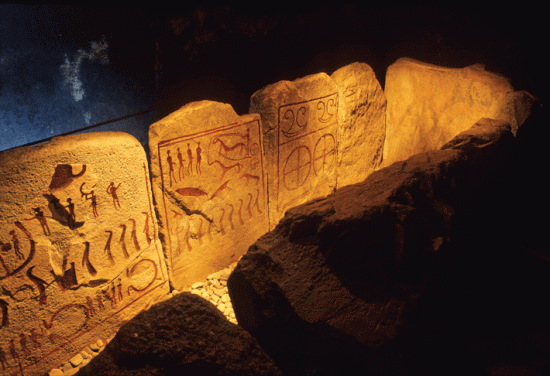
Enigmatic stelae dating from about 1300 to 1000 B.C. were found in a tomb near Kivik, Sweden. One (second from left) may depict a long-standing Indo-European rite initiating boys into the warrior class. Along its bottom, eight hooded figures follow a leader. The number eight may have held some special significance to youthful Indo-European war bands. (© Christophe Boisvieux/Corbis)
Indeed, the number eight may have held some special significance to youthful Indo-European war bands. At a Celtic settlement in France that dates to about A.D. 100, eight horses and eight men were buried together. And in the Siegfried myth, Siegfried tells his nephew not to call for him unless attacked by more than seven men, “which is eight”, states Anthony. “Perhaps, koryos were ideally groups of eight young men, and that fundamental unit of warriors endured into later times”, posits Anthony.
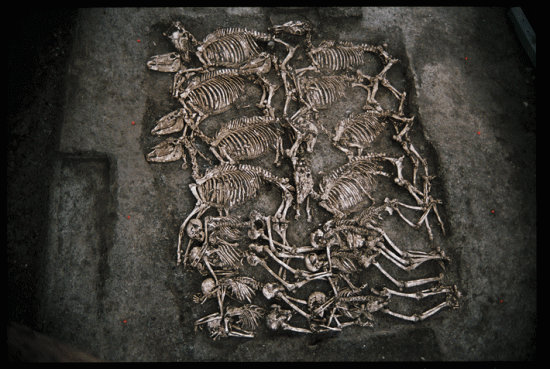
Near a Celtic stronghold in France, a burial dating to about A.D. 100 held the remains of eight men and eight horses. Archaeologist David Anthony thinks that in the Indo-European tradition, eight warriors may have been the ideal complement of youthful war bands. (© Ulysse Cabezuelo, Inrap)
Koryos: the physical evidence
Going back to the finds of Krasnosamarskoe, they provide significant indications that the site had been used for such midwinter koryos initiations. But did this reconstructed tradition existed 4,000 years ago? Once they sent the canine teeth from the site to archaeozoologist Anne Pike-Tay, who studies incremental growth bands on teeth to determine what season an animal died in, the final piece of the puzzle fell into place. She was able to determine that cows sacrificed at the site were killed year-round.By contrast, 16 out of 17 canines were killed in the wintertime -16, which makes two groups of 8. For Anthony and Brown, this was a powerful piece of evidence that koryos existed hundreds of years before they were first mentioned in the Rigveda.
Raiders of Culture
Just as roving bands of youthful raiders played an important role in later Indo-European societies, Anthony thinks they would have been critical to the Timber Grave people. “It was an organized way of not just controlling potentially dangerous young men,” he says, “but it was a way of expanding and gaining wealth.”Anthony thinks koryos could help explain why Indo-European languages spread so successfully. Previous generations of scholars imagined hordes of Indo-Europeans on chariots spreading their languages across Europe and Asia by the point of the sword. But Anthony thinks Indo-European spread instead by way of widespread imitation of Indo-European customs, which included, for example, feasting to establish strong social networks. The koryos could have simply been one more feature of Indo-European life that other people admired and adopted, along with the languages themselves.Anthony is now looking ahead to a time when archaeologists will be willing to use linguistic and literary evidence to understand the prehistoric past in much more subtle ways than they do now. He notes, as an example, that koryos is not the only term for warrior band in reconstructed PIE. There is another word that was apparently used to refer to a larger group of warriors that included all the grown men of a community—surely a very different kind of grouping. “These kinds of distinctions,” he says, “are impossible to dig up with a trowel. We have only barely begun to use the information in the Proto-Indo-European vocabulary to understand the people who spoke it.”
Notes
- Archaeology (info), http://www.archaeology.org/issues/102-1309/features/1205-timber-grave-culture-krasnosamarskoe-bronze-age(17/09/2013)
- Anthony, D and Brown, D. 2012, Midwinter dog sacrifices at LBA Krasnosamarskoe, Russia, and traces of initiations for Männerbünde Paper presented at the seminar "Tracing the Indo-Europeans: Origin and migration", organized by Roots of Europe -- Language, Culture, and Migrations, University of Copenhagen, 12--14 December 2012 http://tinyurl.com/nan5w4n